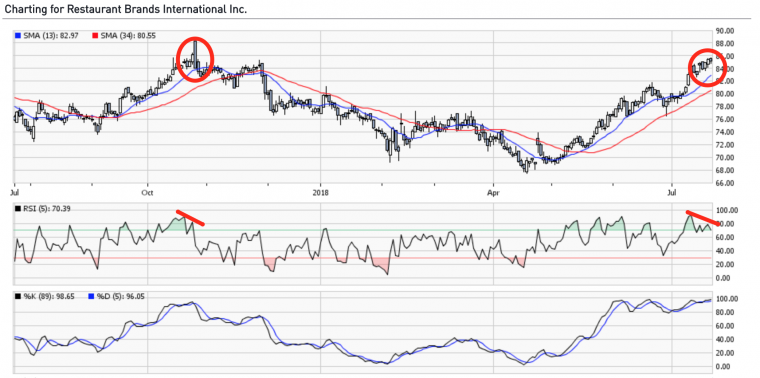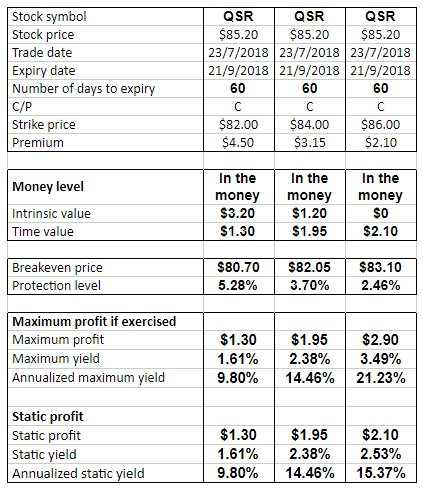Writing call options on a second peak

As the following graph shows, the price of shares in Restaurant Brands International Inc. (QSR) has performed very well since bottoming out at around $68 in April 2018. QSR is trading at $85.20 at this writing, so it is near its previous high, in the $86 to $88 range. As we can see, the overbought and negative divergence conditions on the RSI indicator present at the time of its previous high are in place again. This situation suggests that the stock could pause temporarily at this level, or even initiate a more or less sharp decline.

An investor interested in taking advantage of time decay during this pause, while obtaining some limited protection, could write a call option contract for each 100 shares held. Using a price of $85.20, we will evaluate three call options expiring on September 21, 2018 with strikes of $82, $84 and $86.
Comparison of profit and loss profiles

The above table compares the profit and loss profiles for the covered option writing strategy, based on strikes of $82, $84 and $86.
The call options with an $82.00 strike will pay out a premium of $4.50 per share, or $450 per contract. This in-the-money option, which has an intrinsic value of $3.20 ($85.20 – $82.00) and a time value of $1.30 ($4.50 – $3.20), provides protection of 5.28% if the stock price drops. The maximum profit of $1.30 per share ($82.00 strike – $85.20 stock price + $4.50 premium received) or 1.61% (9.80% annualized) will be obtained if the share price on the September 21 expiration is higher than the $82.00 strike. The static profit – i.e. the profit obtained if the price stays relatively unchanged from now until expiration – is identical to the maximum profit.
The call options with an $84.00 strike will pay out a premium of $3.15 per share, or $315 per contract. This in-the-money call option, which has an intrinsic value of $1.20 ($85.20 – $84.00) and a time value of $1.95 ($3.15 – $1.20), provides protection of 3.70% if the stock price drops. The maximum profit of $1.95 per share ($84.00 strike – $85.20 stock price + $3.15 premium received) or 2.38% (14.46% annualized) will be obtained if the share price on the September 21 expiration is higher than the $84.00 strike. The static profit – i.e. the profit obtained if the price stays relatively unchanged from now until expiration – is identical to the maximum profit.
The call options with an $86.00 strike will pay out a premium of $2.10 per share, or $210 per contract. This in-the-money call option, which has no intrinsic value and a time value of $2.10 ($2.10 – $0), provides protection of 2.46% if the stock price drops. The maximum profit of $2.90 per share ($86.00 strike – $85.20 stock price + $2.10 premium received) or 3.49% (21.23% annualized) will be obtained if the share price on the September 21 expiration is higher than the $84.00 strike. The static profit – i.e. the profit obtained if the price stays relatively unchanged from now until expiration – is $2.10 per share (the time value of the call options), representing a return of 2.53% (15.37% annualized).
When choosing the strike, a compromise must be made between maximum return and the protection offered against a drop in price.
Intervention
In the event that the stock price falls or is relatively unchanged, we can buy back the call options written for a price of between 10% and 20% of the initial price. In this case, an analysis should be performed to confirm whether it is still worthwhile to write more call options for protection. Should the stock price be unchanged or rise above the strike, the call options should be bought back at a profit or a loss, depending on the circumstances, in order to avoid having them assigned and being obliged to sell the underlying assets.
Note that a $0.45 dividend will be paid around September 14. As a result, if the call options chosen are in the money on September 13, they may be exercised prematurely, and we will then be obliged to sell the shares. Should this occur, we will not be able to take the dividend. To avoid this from happening, the position will need to be closed by buying back the call options just before September 14 if they are in the money.
Good luck with your trading, and have a good week!
The strategies presented in this blog are for information and training purposes only, and should not be interpreted as recommendations to buy or sell any security. As always, you should ensure that you are comfortable with the proposed scenarios and ready to assume all the risks before implementing an option strategy.
President
Monetis Financial Corporation
Martin Noël earned an MBA in Financial Services from UQÀM in 2003. That same year, he was awarded the Fellow of the Institute of Canadian Bankers and a Silver Medal for his remarkable efforts in the Professional Banking Program. Martin began his career in the derivatives field in 1983 as an options market maker for options, on the floor at the Montréal Exchange and for various brokerage firms. He later worked as an options specialist and then went on to become an independent trader. In 1996, Mr. Noël joined the Montréal Exchange as the options market manager, a role that saw him contributing to the development of the Canadian options market. In 2001, he helped found the Montréal Exchange’s Derivatives Institute, where he acted as an educational advisor. Since 2005, Martin has been an instructor at UQÀM, teaching a graduate course on derivatives. Since May 2009, he has dedicated himself full-time to his position as the president of CORPORATION FINANCIÈRE MONÉTIS, a professional trading and financial communications firm. Martin regularly assists with issues related to options at the Montréal Exchange.
The information provided on this website, including financial and economic data, quotes and any analysis or interpretation thereof, is provided solely for information purposes and shall not be construed in any jurisdiction as providing any advice or recommendation with respect to the purchase or sale of any derivative instrument, underlying security or any other financial instrument or as providing legal, accounting, tax, financial or investment advice. Bourse de Montréal Inc. recommends that you consult your own advisors in accordance with your needs before making decision to take into account your particular investment objectives, financial situation and individual needs.
All references on this website to specifications, rules and obligations concerning a product are subject to the rules, policies and procedures of Bourse de Montréal Inc. and its clearinghouse, the Canadian Derivatives Clearing Corporation, which prevail over the content of this website. Although care has been taken in the preparation of the documents published on this website, Bourse de Montréal Inc. and/or its affiliates do not guarantee the accuracy or completeness of the information published on this website and reserve the right to amend or review, at any time and without prior notice, the content of these documents. Neither Bourse de Montréal Inc. nor any of its affiliates, directors, officers, employees or agents shall be liable for any damages, losses or costs incurred as a result of any errors or omissions on this website or of the use of or reliance upon any information appearing on this website.
BAX®, CADC®, CGB®, CGF®, CGZ®, LGB®, MX®, OBX®, OGB®, OIS-MX®, ONX®, SCF®, SXA®, SXB®, SXF®, SXH®, SXM®, SXO®, SXY®, and USX® are registered trademarks of the Bourse. OBW™, OBY™, OBZ™, SXK™, SXJ™, SXU™, SXV™, Montréal Exchange and the Montréal Exchange logo are trademarks of the Bourse. All other trademarks used are the property of their respective owners.
© 2024 Bourse de Montréal Inc. All Rights Reserved.
